

Microsoft Word - 2 Enduring Understandings and Essential Questions.docx. What is Singapore Math? The Method The Singapore math method is focused on mastery, which is achieved through intentional sequencing of concepts.
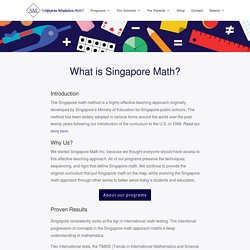
Some of the key features of the approach include the CPA (Concrete, Pictorial, Abstract) progression, number bonds, bar modeling, and mental math. Instead of pushing through rote memorization, students learn to think mathematically and rely on the depth of knowledge gained in previous lessons. An attitude that math is important and approachable is also essential. Students perform at a higher level when their potential for understanding and success is assumed. So how is this different from the way math is widely taught in the U.S.? In typical U.S. math programs, students get a worked example, then solve problems that very closely follow that example, repeating all the same steps with different numbers.
FluencyWithoutFear 2015 1. What is Effective Teaching of Mathematics? - They recognize the importance of using concrete materials and visual representations to develop a deep understanding of the subject.

They have a clear picture of the learning progression that best develops the knowledge base and skills of their students. They also have a broad palate of learning experiences they can use in the classroom, to meet the different learning needs of each student. Effective teachers are able to look at student misconceptions, either in the classwork, through homework, or through assessments, and reteach the material using their understanding of the developmental nature of what becomes before or after the misconception.
Deep understanding of the content enables teachers to directly address the specific misunderstandings that students may have. Such teachers need to be continual learners. Effective teachers know what students need to know Effective teachers augment fluency procedure with: Nine “Look Fors” in the Elementary Math Classroom. By Sue O’Connell and John SanGiovanni, adapted from A Guide for Administrators, part of the new Math in Practice resource What do we hope to see and hear when we step into a math classroom?
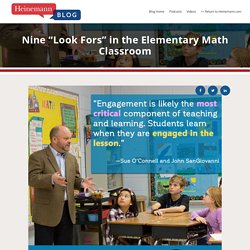
As our focus has shifted from memorizing to understanding and from calculating to applying, we have recognized instructional strategies that are better suited to these goals. As we observe math classrooms, we look for evidence that teaching is more than delivering a textbook lesson. We look at the interactions between teacher and students, the on-the-spot decisions made by the teacher to keep learning progressing, and the ways in which the teacher brings math ideas to light through talk, visuals, and making connections to past learning.
More specifically, here are some key features we would hope to see in an effective math classroom. Without a clear focus on the standard being addressed, teaching can get side-tracked. The effective mathematics classrroom. Getting Started with Number Talks. Showing What We KNOW in Math Journals. 5 years ago I took a CGI (Cognitive Guided Instruction) training and loved everything about it.
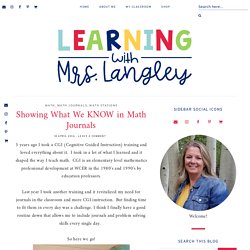
I took in a lot of what I learned and it shaped the way I teach math. CGI is an elementary level mathematics professional development at WCER in the 1980's and 1990's by education professors. Last year I took another training and it revitalized my need for journals in the classroom and more CGI instruction. But finding time to fit them in every day was a challenge. I think I finally have a good routine down that allows me to include journals and problem solving skills every single day. So here we go! Journals are pretty simple. Here is our math journal routine: Math Disabilities Support. 10 DEVELOPING PROFICIENCY IN TEACHING MATHEMATICS. Campbell, P.F. (1996).
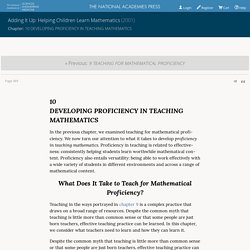
Empowering children and teachers in the elementary mathematics classrooms of urban schools. Urban Education, 30, 449–475. Carpenter, T.P. (1988). Teaching as problem solving. Mathematics Standards. For more than a decade, research studies of mathematics education in high-performing countries have concluded that mathematics education in the United States must become substantially more focused and coherent in order to improve mathematics achievement in this country.

To deliver on this promise, the mathematics standards are designed to address the problem of a curriculum that is “a mile wide and an inch deep.” These new standards build on the best of high-quality math standards from states across the country. They also draw on the most important international models for mathematical practice, as well as research and input from numerous sources, including state departments of education, scholars, assessment developers, professional organizations, educators, parents and students, and members of the public. Amy Lemons Teaching Resources. What Does It Mean To Understand Mathematics?
If you think others need to see this, share it on one of the sites below by clicking on the button.
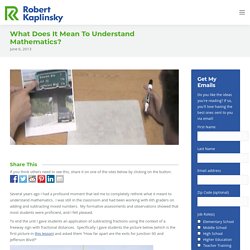
Several years ago I had a profound moment that led me to completely rethink what it meant to understand mathematics. I was still in the classroom and had been working with 6th graders on adding and subtracting mixed numbers. My formative assessments and observations showed that most students were proficient, and I felt pleased. To end the unit I gave students an application of subtracting fractions using the context of a freeway sign with fractional distances.
Specifically I gave students the picture below (which is the first picture in this lesson) and asked them “How far apart are the exits for Junction 90 and Jefferson Blvd?” I clearly expected students to do well with this problem, but as I walked around checking students’ progress I realized that something strange was going on. Relatively few students got 1/4. Is this student demonstrating a rigorous mathematical understanding? What is Subitizing? - Make Take & Teach. What Is The Concrete Representational Abstract Approach.